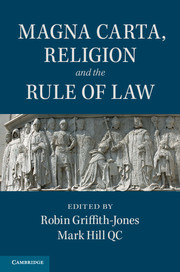Book contents
- Frontmatter
- Contents
- List of contributors
- Preface and acknowledgments
- I Introduction
- II The birth of Magna Carta and the spread of its principles
- III Comparative religious approaches to Magna Carta's rule of law
- IV The contemporary inheritance of Magna Carta
- 15 The development of human rights thought from Magna Carta to the Universal Declaration of Human Rights
- 16 Strasbourg's approach to religion in the pluralist democracies of Europe
- 17 The Great Covenant of Liberties: biblical principles and Magna Carta
- 18 The cardinal rule of religion and the rule of law: a musing on Magna Carta
- 19 Strengthened by the rule of law: the message of Magna Carta for religions today
- Appendix The Charters in translation
- Bibliography
- Index
17 - The Great Covenant of Liberties: biblical principles and Magna Carta
from IV - The contemporary inheritance of Magna Carta
Published online by Cambridge University Press: 05 May 2015
- Frontmatter
- Contents
- List of contributors
- Preface and acknowledgments
- I Introduction
- II The birth of Magna Carta and the spread of its principles
- III Comparative religious approaches to Magna Carta's rule of law
- IV The contemporary inheritance of Magna Carta
- 15 The development of human rights thought from Magna Carta to the Universal Declaration of Human Rights
- 16 Strasbourg's approach to religion in the pluralist democracies of Europe
- 17 The Great Covenant of Liberties: biblical principles and Magna Carta
- 18 The cardinal rule of religion and the rule of law: a musing on Magna Carta
- 19 Strengthened by the rule of law: the message of Magna Carta for religions today
- Appendix The Charters in translation
- Bibliography
- Index
Summary
Magna Carta can be read as a historical, constitutional or legal document. But it was first and foremost a religious document. It was sealed by King John in 1215 ‘from reverence for God and for the salvation of our soul and those of all our ancestors and heirs, for the honour of God and the exaltation of Holy Church and the reform of our realm’. The king was acting on the advice of two archbishops and nine bishops. The Charter itself was in many ways the work of Archbishop Stephen Langton. Langton had in his Parisian exile been among the most famous lecturers on the churches’ Old Testament. Moses had commanded in Deuteronomy, that if a king were chosen,
After [the king] has sat down on the throne of his kingdom he will write out for himself the Deuteronomy of this law in a book, taking an exemplar from the priests of the levitical tribe; and he will have it with him and will read it all the days of his life so that he might learn to fear the Lord his God and observe his words and ceremonies which are written in the law and so that his heart may not be raised into pride over his brothers nor veer to the right or to the left.
(Deuteronomy 17:18–20, Latin)The law, argued Langton, was written down in Deuteronomy to prevent the king from demanding more power than had been agreed. Langton had in particular studied Saul's acclamation as king over Israel: ‘Samuel declared to the people the law of the kingdom and wrote it in a book and deposited it in the presence of the Lord’ (1 Samuel 10:25).
What had been true in ancient Israel was to be true in medieval England. Langton was trying in his contributions to the Charter to realise in England a biblical, covenantal kingship. The Charter would soon be known as the Great Charter of Liberties. It is in the form of a covenant of liberties: a covenant between God, the king and the people, laying down the principles on which the king would reign.
- Type
- Chapter
- Information
- Magna Carta, Religion and the Rule of Law , pp. 301 - 313Publisher: Cambridge University PressPrint publication year: 2015
- 1
- Cited by

